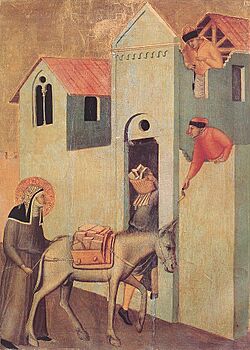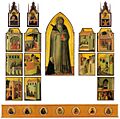Saint Humility facts for kids
Quick facts for kids Saint Humility |
|
|---|---|

Saint Humility transports bricks to build the monastery.
|
|
| Born | Rosanna Negusanti c. 1226 Faenza, Italy |
| Died | 22 May 1310 Florence, Italy |
| Venerated in | Roman Catholic Church |
| Canonized | 27 January 1720, Saint Peter's Basilica, Rome, Papal States by Pope Clement XI |
| Major shrine | Monastery of the Holy Spirit in Bagno a Ripoli on the outskirts of Florence |
| Feast | 22 May |
| Attributes | depicted as a nun |
| Patronage | Faenza |
Saint Humility (Latin: Humilitas; Italian: Umiltà), born around 1226 and passing away on May 22, 1310, was also known as Saint Roxanne (Italian: Santa Rosanna). She was a very important figure who founded a group of nuns called the Vallumbrosan Nuns. Her life story is one of dedication and faith.
Contents
Who Was Saint Humility?
Early Life and Family
Saint Humility was born Rosanna Negusanti in Faenza, Italy, around the year 1226. Her family was noble, which meant they were important and well-known in their community.
When she was about fifteen years old, Rosanna married a nobleman named Ugoletto dei Caccianemici. Sadly, their two children both passed away when they were very young.
A New Path: Becoming a Nun
In 1250, Rosanna and her husband decided to dedicate their lives to God. They both entered a special religious community called a double monastery near Faenza. In this place, men and women lived separately but followed a similar religious path.
Rosanna became a canoness, which is a type of nun. When she joined, she chose a new name: Humilitas. This name means "Humility," which is a quality of being humble and modest.
Living as a Hermit
In 1254, Humility chose to live a very quiet life as an anchoress. This meant she lived alone in a small room, called a cell, attached to a church. For twelve years, she lived as a hermit, focusing on prayer and simple living.
Her example inspired other young women in Faenza. They wanted to live a similar life and asked to build their own cells near hers. They wished to follow her guidance and learn from her.
Founding Monasteries
Because of her strong faith and the interest of others, Humility was asked to do something new in 1266. The leader of the Vallumbrosan order asked her to start a new monastery for nuns outside Faenza. This monastery became known as Santa Maria Novella alla Malta. Humility became its abbess, which means she was the leader of the nuns there.
Later, in 1282, she founded a second convent in Florence. A convent is another name for a monastery where nuns live. This new convent was dedicated to Saint John the Evangelist. Saint Humility lived there until she passed away in 1310.
The convent in Florence was decorated by a famous artist named Buonamico Buffalmacco. It was officially blessed in 1297 by Bishop Francesco Monaldeschi.
Writings and Legacy
Saint Humility left behind several writings. She is especially known for writing and preaching nine sermons in Latin. She also wrote beautiful songs of praise, called Lauds, to the Virgin Mary.
On January 27, 1720, Pope Clement XI officially recognized her as a saint. This was called confirming her "ancient cult," meaning her long-standing veneration as a holy person.
In 1942, she was declared a co-patron of Faenza. This means she is considered a special protector of the city, alongside other saints. Altars were dedicated to her in the two monasteries she founded. Her feast day, which is a day to celebrate her life, is on May 22.
In 1972, Saint Humility's relics (her remains) were moved to the Monastery of the Holy Spirit. This monastery is located in Bagno a Ripoli, just outside Florence.
Images for kids


